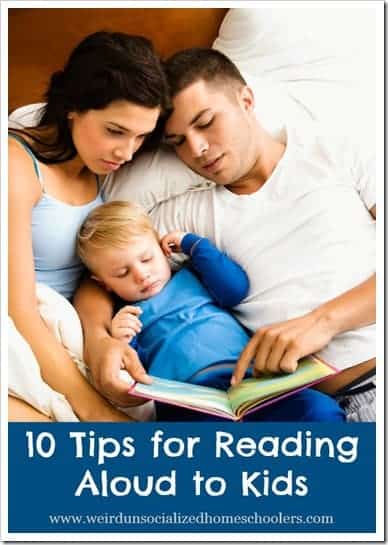10 Tips for Reading Aloud to Kids
I began reading aloud to my kids from the time they were infants. Even though the oldest is now 18, they still enjoy hearing a good book read aloud. There are some tips for reading aloud to kids that will enhance the experience.

1. Enunciate. I’m not talking about saying each and every word distinctly and clearly complete with pauses between, but sometimes, when reading aloud, it’s a good idea to enunciate more than you would in your natural speaking voice. When you’re only hearing the words, rather than seeing them, as your listeners are, it can be easy to misunderstand if words aren’t spoken clearly.
2. Read slowly. I’ve read many times before the biggest mistake people make when reading aloud is reading too quickly. Again, your kids don’t want to hear you read in slow motion, but read a bit more slowly than you normally speak so that they don’t miss anything.
3. Use voices. I’ll be the first to admit that I am terrible at this and rarely do it. I often think, with envy, how much Robin Williams’ kids (does he have any?) must have enjoyed listening to him read. If you can pull it off, giving your characters different voices makes the story more fun and it makes it much easier to follow changes in dialogue for your listeners.
4. Show your kids the pictures. Even now, when I’m reading aloud to my tween and teens, I show them the pictures if there are any. With picture books, the illustrations often tell as much of the story as the words do, so make sure you’re taking time to look at the pictures with your kids. Point out things they may not notice or ask questions about what’s going on in the pictures.
There’s just nothing quite like a beautifully illustrated picture book.
5. Make sure they’re following the story. When reading a book with language or a storyline that is challenging for my listeners, I like to make sure they’re following the story. We read The Hound of the Baskervilles earlier this year. The language could be difficult for my kids to follow, so after I read a part that I suspected they might not understand, I’d ask them.
If they hadn’t really followed that part, I’d explain it. This paid off well because the more they got used to the writing style, the easier they found it to understand. About halfway through the book, they were begging me to keep reading whenever I’d stop at a suspenseful part. This was a complete turn around from the initial complaining that that book was boring.
6. Define unclear words. Reading aloud is a great chance to expose kids to unfamiliar vocabulary. For that reason, I like to define words that they probably don’t know…or, sometimes, words that I don’t know. I love being able to define a word right in the text when I’m using the Kindle app on my iPad.
I’ve only had the iPad a few weeks, but there have already been several times when I’ve thought about how helpful it would be to the kids to have a Kindle. When I’m reading a print book to myself, there are very few times that I’ll stop to look up an unfamiliar word, but it’s so easy to do when reading on the iPad.
7. But not all of them. It’s a good idea to define some of the unfamiliar words, but you certainly shouldn’t do that for all of them. Stopping frequently to define words is a good way to lose the thread of the story. Not only that, but often kids (and adults) can pick up the meaning of the word in context based on how it’s used in the sentence. That’s a good skill for kids to develop.
An alternative is to jot down unfamiliar words as you’re reading (you can write them or have the kids make their own lists) so that you can look them up when you’re finished.
8. Don’t stop when they get older. Don’t stop reading aloud to your kids once they are reading independently. As I said, even my 18 year old still enjoys listening to a good book. By continuing to read aloud to your older kids, you have opportunities to enjoy books together and to expose them to higher reading levels than they might be able to read on their own.
Plus, I love the idea of developing a family language through shared stories. Because Brianna and I are the only two in our family who have read the Twilight books, we have that kind of shared language. Quotes from the books are like inside jokes that we enjoy together.
9. Use audio and print books. If you like the idea of reading aloud, but can’t or don’t want to do all the reading yourself, consider audio books. I use audio books a lot with my dyslexic readers. They’re a great way to allow a struggling reader to still enjoy great books that he or she find too cumbersome to read independently.
One thing I really like to do is get both the audio and print book. That way, the reader can follow along with the words. Seeing and hearing the vocabulary is a great combination for a struggling reader because seeing the words as they’re read aloud make it much more likely that he’ll recognize the word the next time he sees it in print.
10. Make homemade “turn the page” books. I made reference to this in my post about 15+ picture books I’m saving for my grandkids, but I love the idea of making homemade turn the page books for my grandkids some day. This would be a great idea, too, for a parent who travels a lot – or a parent who doesn’t travel a lot and is having to leave a child who’s not used to Mom or Dad being gone. It could also be fun if you make use of room time for your kids.
If you’re old like me, you may remember those Disney recorded books that said, “You will know it is time to turn the page when Tinkerbell rings her bell like this…” Basically, you make a recording of yourself reading the book aloud and you ring a bell (or some other sound) when it’s time for the child to turn the page. That way, she can follow along as Mom or Dad reads the book even if Mom or Dad can’t be there.
Do you read aloud to your kids regularly? What tips would you add?
Kris Bales is a newly-retired homeschool mom and the quirky, Christ-following, painfully honest founder (and former owner) of Weird, Unsocialized Homeschoolers. She has a pretty serious addiction to sweet tea and Words with Friends. Kris and her husband of over 30 years are parents to three amazing homeschool grads. They share their home with three dogs, two cats, a ball python, a bearded dragon, and seven birds.




We have read aloud to our son, who is almost 8, since we brought him home from the hospital, maybe before that! And, we haven’t stopped. Our son loves books and reading, and I think reading aloud has helped foster that. He also sees my husband and I reading for pleasure. One thing I would say, is this: as a homeschooler, I read aloud a lot during the day – science, history, reading, etc. It’s easy to forget to read aloud just for pleasure, or to be burned out on reading aloud. We pick a book – right now it’s “Treasure Island” that my husband reads aloud with our son in the evening to keep the tradition going.
If you’re looking for further encouragement, read Jim Trelease’s book “The Read-Aloud Handbook”. I can’t recommend it enough!
Your tip for homeschooling families is a great one. I admit that I can be guilty of that very thing. And, I love Jim Trelease’s book! I’ve got a copy around here somewhere.
Good tips! I still read to my kids even though the oldest is 13.
When they were young, I did my best not to turn the page too soon. I found that when I paused before turning the page, my child would interact with the book somehow: comment on the passage or picture, ask what a word means, predict what would come next.
That pause, sometimes with a leading question, led to some rich discussions, and an understanding on my children’s part that books are conversations, not things to check off of a list.
Great tip! When my kids were little, I would often do that without thinking – because I was trying to look at the pictures, too! 🙂
My mom always started out homeschool day with a read aloud. I remember we could talk her into reading “just one more chapter” because she was so into the book 🙂 I was smiling while reading this because my boys and I decided to keep reading the Magicians Nephew this morning instead of doing our normal morning school work. I feel like it just adds to my teaching that reading is important and interesting. Great post, thanks for sharing!
Yeah, my kids get away with that “just a little longer” thing when we’re engrossed in a good book. They can also get away with staying up later to read. Or asking me to buy books. 🙂
I am terrible at this, really. We mostly read aloud when we are doing road trips. I just have such a hard time forcing myself to sit and read to my children. Even thought I know that studies have shown what a huge benefit this is to growth and development. Excellent suggestions!
Our read-aloud time is the highlight of our day! Now, I only have one child – he’s 10 – at home, the older three either working or at college, but of all the ‘subjects’ we may have to drop out of a day with lack of time, read-aloud is NOT one of them! Bible time, Math, Language and Read-aloud are our ‘staples’, with History, Geography and Science on our agenda the days we can.
Right now, we’re reading the Viking Quest series, but we both agree that the Little House series was probably the highlight (so far) of our homeschooling years. Happy, happy memories 🙂